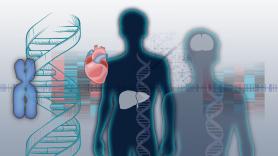The Human Genome Project, completed in 2003, launched a revolution cut short. It was the first to sequence our DNA and led to the ever-falling price of the techniques that made this large-scale sequencing possible. It came with the promise of helping us understand our biology and the deviations that manifest in illness, but only scratched the very surface of the darkness. It showed us that there were many, many more layers underneath.
When looking for associations between DNA and illness, most weren't found in the 2-3% made up of genes but outside of them. They were in what is called the dark genome, which for years was believed to have no purpose. After that, the ENCODE project established, however, that up to 80% of the whole genome is involved in some sort of activity. The majority of dark DNA regulates the activity (reading) of genes. Depending on how it is done in each place, there can be different cells (heart, kidney, brain) even though they all have similar DNA.
The GTEx project (genotype-tissue expression) took it one step further. Its purpose was to establish the relationship between genetics and expression (different readings) in the form of RNA and proteins in each type of tissue. These ties should explain the dark associations found in studies. And help understand the basis of how the genome and each disease works. To do so, more than 20,000 tissue samples from nearly one thousand donors are being analyzed and the data is being shared openly.
Members of the project, all international experts, met for the first time in Europe to share the most recent advances. They did so on 20 and 21 April 2017 at the debate ‘The Genotype Tissue Expression (GTEx) Project Community Meeting. Enhancing the Usage of Human Genomics for the benefit of all’ organized by the Center for Genomic Regulation (CRG) and B·Debate, an initiative of Biocat and the “la Caixa” Foundation to promote scientific debate.
CONCLUSIONS:
- The GTEx project has already collected data from more than 20,000 samples from 960 donors. Studying these will allow this project to go further than the Genome Project.
- Most associations made between genetics and illnesses found in large studies weren't in genes, so they were hidden. GTEx analyzes these associations and the DNA expression of each sort of tissue, trying to shed light on the mechanisms involved.
- Some of the analyses are helping advance fields like diabetes, cardiovascular disease, cancer and autism. There is even pharmacogenetics, allowing doctors to prescribe drugs based on a patent's genetic profile.
- The information is allowing researchers to study DNA architecture and how it works, including the way some regions communicate with others within a certain tissue.



